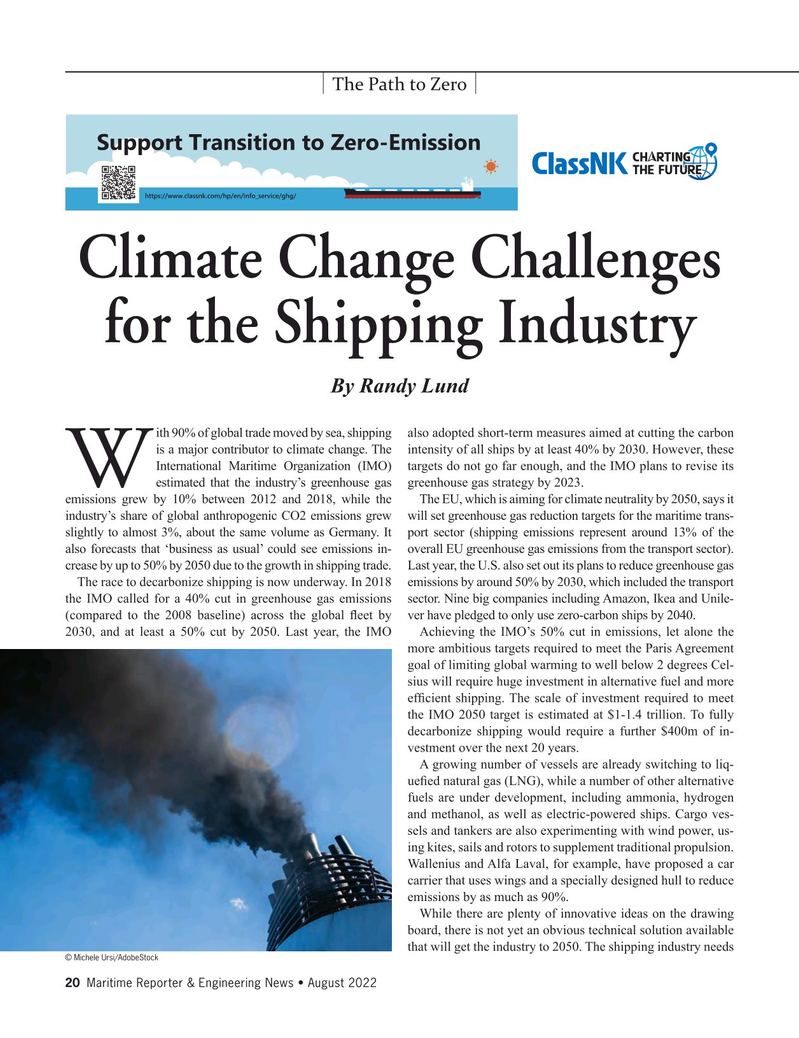
Page 20: of Maritime Reporter Magazine (August 2022)
The Shipyard Annual
Read this page in Pdf, Flash or Html5 edition of August 2022 Maritime Reporter Magazine
The Path to Zero
Climate Change Challenges for the Shipping Industry
By Randy Lund ith 90% of global trade moved by sea, shipping also adopted short-term measures aimed at cutting the carbon is a major contributor to climate change. The intensity of all ships by at least 40% by 2030. However, these
International Maritime Organization (IMO) targets do not go far enough, and the IMO plans to revise its
W estimated that the industry’s greenhouse gas greenhouse gas strategy by 2023.
emissions grew by 10% between 2012 and 2018, while the The EU, which is aiming for climate neutrality by 2050, says it industry’s share of global anthropogenic CO2 emissions grew will set greenhouse gas reduction targets for the maritime trans- slightly to almost 3%, about the same volume as Germany. It port sector (shipping emissions represent around 13% of the also forecasts that ‘business as usual’ could see emissions in- overall EU greenhouse gas emissions from the transport sector). crease by up to 50% by 2050 due to the growth in shipping trade. Last year, the U.S. also set out its plans to reduce greenhouse gas
The race to decarbonize shipping is now underway. In 2018 emissions by around 50% by 2030, which included the transport the IMO called for a 40% cut in greenhouse gas emissions sector. Nine big companies including Amazon, Ikea and Unile- (compared to the 2008 baseline) across the global ? eet by ver have pledged to only use zero-carbon ships by 2040.
2030, and at least a 50% cut by 2050. Last year, the IMO Achieving the IMO’s 50% cut in emissions, let alone the more ambitious targets required to meet the Paris Agreement goal of limiting global warming to well below 2 degrees Cel- sius will require huge investment in alternative fuel and more ef? cient shipping. The scale of investment required to meet the IMO 2050 target is estimated at $1-1.4 trillion. To fully decarbonize shipping would require a further $400m of in- vestment over the next 20 years.
A growing number of vessels are already switching to liq- ue? ed natural gas (LNG), while a number of other alternative fuels are under development, including ammonia, hydrogen and methanol, as well as electric-powered ships. Cargo ves- sels and tankers are also experimenting with wind power, us- ing kites, sails and rotors to supplement traditional propulsion.
Wallenius and Alfa Laval, for example, have proposed a car carrier that uses wings and a specially designed hull to reduce emissions by as much as 90%.
While there are plenty of innovative ideas on the drawing board, there is not yet an obvious technical solution available that will get the industry to 2050. The shipping industry needs © Michele Ursi/AdobeStock 20 Maritime Reporter & Engineering News • August 2022
MR #8 (18-33).indd 20 8/1/2022 10:16:55 AM

 19
19

 21
21
